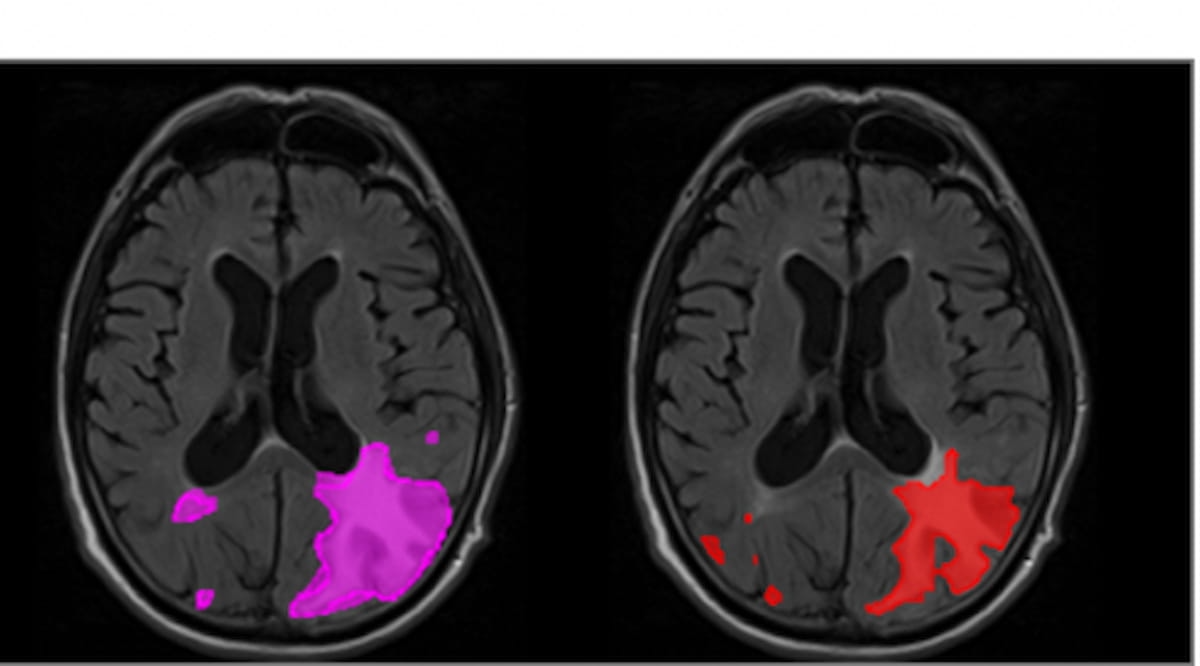Noting previous literature that showed missed diagnosis of amyloid-related imaging abnormalities (ARIAs) ranging from 14 to 42 percent, the authors of a new study suggest that artificial intelligence (AI) can lead to significant improvements for magnetic resonance imaging (MRI) detection of ARIAs in patients with Alzheimer’s disease.1,2
For the retrospective study, which was recently published in JAMA Network Open, researchers assessed the use of an AI-enabled software (Icobrain Aria, icometrix) for detecting ARIAs by comparing baseline and follow-up MRI scans for 199 patients (mean age of 70.4) treated for Alzheimer’s disease.3
The cases included 84 patients who had ARIA-E (edema and/or sulcal effusion) and ARIA-H (microhemorrhage and/or superficial siderosis); 40 patients without ARIA-E or ARIA-H; 39 patients with only ARIA-E; and 36 patients with only ARIA-H, according to the study.3
The study authors found that adjunctive use of the AI software led to an 87 percent sensitivity rate for ARIA-E in comparison to 71 percent for unassisted radiologist reading. The researchers also noted a 10 percent increase in sensitivity for the diagnosis of ARIA-H with AI in contrast to unassisted reading (79 percent vs. 69 percent).3
“This diagnostic study found that an assistive software tool was associated with improved diagnostic performance compared with unassisted radiographic assessment of ARIA, for general and specialized radiologists alike, thereby expanding access to reliable ARIA monitoring in clinical practice,” wrote Diana M. Sima, Ph.D., a senior researcher at icometrix, and colleagues.
The most significant improvement in sensitivity with adjunctive AI was a 23 percent increase in diagnosing mild ARIA-E (70 percent vs. 47 percent for unassisted radiologists), according to the study authors. The researchers also noted that AI software facilitated an 8 percent increase in sensitivity for moderate and severe ARIA-H (94 percent vs. 86 percent for unassisted reading).3
Three Key Takeaways
- Improved sensitivity with AI assistance. The study suggests the use of an AI-enabled software (Icobrain Aria) significantly improves sensitivity in detecting amyloid-related imaging abnormalities (ARIAs) in Alzheimer’s disease patients undergoing MRI. Specifically, there was an 87% sensitivity rate for ARIA-E (edema and/or sulcal effusion) and a 10% increase in sensitivity for ARIA-H (microhemorrhage and/or superficial siderosis) compared to unassisted radiologist reading.
- Enhanced diagnostic performance for ARIA. The study found that the AI software provided better diagnostic performance than unassisted radiographic assessment for ARIAs, benefiting both general and specialized radiologists. The most notable improvement was observed in diagnosing mild ARIA-E, with a 23% increase in sensitivity. Additionally, there was an 8% increase in sensitivity for moderate and severe ARIA-H with AI assistance.
- Maintained efficiency and showed higher inter-reader agreement. The use of adjunctive AI did not significantly prolong the reading time compared to unassisted reading, according to the study. Furthermore, the study showed higher inter-reader agreement percentages for both ARIA-E and ARIA-H severity when AI was used.
Adjunctive AI also resulted in higher percentages of inter-reader agreement for ARIA-E severity (81 percent vs. 72 percent) and ARIA-H severity (80 percent vs. 66 percent) in comparison to unassisted reading, according to the study authors.3
“In this study, unassisted radiologists distinguished ARIA grades well … but tended to further improve and had higher inter-reader agreement with software assistance both for ARIA-E and ARIA-H,” added Sima and colleagues. “Moreover, assisted reading did not take more time than unassisted reading.”
The researchers did note lower specificity rates with the AI software for ARIA-E (83 percent vs. 92 percent for unassisted reading) and ARIA-H (80 percent vs. 83 percent for unassisted reading).3
(Editor’s note: For related content, see “FDA Clears Emerging AI Software for Brain MRI,” “Can Abbreviated MRI Have an Impact in Neuroimaging?” and “FDA Clears AI-Powered MRI Software to Assess for Brain Atrophy.”)
In regard to study limitations, the authors acknowledged small sample sizes and limited diversity in the cohort. Noting the modality’s lack of training on macrohemorrhage segmentation, the researchers did not assess the capability of the AI software for diagnosing cerebral hemorrhages larger than 1 cm.
References
1. Gutt S, Brocco A, Sharma S. Variability of ARIA detection in patients receiving monoclonal antibodies against amyloid-B plaques. Presented at the Alzheimer’s Association International Conference, July 14-18, 2019, Los Angeles.
2. Sperling R, Salloway S, Brooks DJ, et al. Amyloid-related imaging abnormalities in patients with Alzheimer’s disease treated with bapineuzumab: a retrospective analysis. Lancet Neurol. 2012;11(3):241-249.
3. Sima DM, Van Phan T, Van Eyndhoven S, et al. Artificial intelligence assistive software tool for automated detection and quantification of amyloid-related imaging abnormalities. JAMA Netw Open. 2024;7(2):e2355800. doi: 10.1001/jamanetworkopen.2023.55800 . Online ahead of print.
